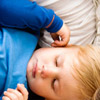Bedwetting or Nocturnal Enuresis (NE) [nocturnal meaning night; and enuresis meaning involuntary urination] is a common medical condition that can affect up to 19% of school-aged children. If left untreated, this condition may interfere with social activities, relationships and performance at school. A child’s self-esteem may also suffer. Fortunately most of these children will outgrow bedwetting, but for some the condition might persist into adulthood.
Bedwetting can be treated, and the type of treatment is based on the assessment of the underlying cause of a child’s bedwetting.
Bedwetting may be caused by one or more factors such as difficulty to rouse from sleep, an overactive or “twitchy” bladder and an overproduction of urine during the night.
Bedwetting can be classified into 2 types:
- Monosymptomatic nocturnal enuresis (most common) is when bedwetting occurs without any other urinary symptoms.
- Non-monosymptomatic nocturnal enuresis is bedwetting in addition to other urinary symptoms, such as daytime wetting, urinating frequently during the day, and often feeling an urgent need to urinate.
In addition, the term primary nocturnal enuresis is used to describe bedwetting in a child who has wet the bed since birth without a period of complete dryness for more than six months, whereas secondary nocturnal enuresis refers to bedwetting in a child who had been dry previously for at least six months but has recommenced wetting the bed. Secondary nocturnal enuresis is more likely to be associated with psychological factors or a problem that’s developed with the child’s urinary system.
So, if your child is 6 years of age or older, is wetting the bed and is unhappy and uncomfortable about it, you should consider speaking to your doctor about it. To help start a conversation with your doctor about your child’s bedwetting, it may be helpful to first download and use the My Dryness Tracker App. This App has been developed for carers planning to see a doctor about a child who is wetting the bed or for those caring for a child who is undergoing treatment for bedwetting.
The App includes:
Bedwetting checklist
- Day-time and night-time voiding diaries
- Treatment progress trackers
- Enuresis alarm ordering facility
- Treatment progress reports
Perth GP Dr Joe Kosterich said “the App is a useful way for doctors to gain insights into a child’s bedwetting patterns.”
“This App facilitates easy self-reporting where patterns may emerge that were previously difficult to observe. Such detailed information can assist GPs to determine the best course of treatment.” Dr Kosterich said.
The My Dryness Tracker is a free App for smartphones and tablets and it is available from the App Store and Google Play.
Kindly written and reviewed by Dr Allison Johns BSc (Hons) MBBS, Doctor at King Edward Memorial Hospital and Editorial Advisory Board Member of Virtual Medical Centre.
 |
For more information about bed wetting including lifestyle advice, how the urinary system works and much more, see Bed Wetting (Nocturnal Enuresis). |
References
- Caldwell PH, Edgar D, Hodson E, Craig JC. Bedwetting and toileting problems in children. Med J Aust. 2005;182(4):190-5. [Abstract | Full text]
- Schulpen TW. The burden of nocturnal enuresis. Acta Paediatr. 1997;86(9):981-4. [Abstract]
- Yeung C, Sihoe J, Sit F. Characteristics of primary nocturnal enuresis in adults: an epidemiological study. British Journal of Urology. 2004; 93: 341-345. [Abstract | Full Text]
- National Institute for Health and Clinical Excellence. NICE clinical guideline 111 – Nocturnal Enuresis: the management of bedwetting in children and young people. Issue date October 2010. Available from [URL Link]
- Nevéus T, von Gontard A, Hoebeke P, et al. The standardization of terminology of lower urinary tract function in children and adolescents: Report from the Standardisation Committee of the International Children’s Continence Society. J Urol. 2006;176(1):314-24. [Abstract | Full text]
- Brown ML, Pope AW, Brown EJ. Treatment of primary nocturnal enuresis in children: A review. Child Care Health Dev. 2011;37(2):153-60. [Abstract]
- Nevéus T. Nocturnal enuresis: Theoretic background and practical guidelines. Pediatr Nephrol. 2011;26(8):1207-14. [Abstract | Full text]
- Bottomley G. Treating nocturnal enuresis in children in primary care. Practitioner. 2011;255(1741):23-6. [Abstract]
- Zentir Pty Ltd. My Dryness Tracker. April 10, 2013. Accessed 26th February 2013 [Online]
All content and media on the HealthEngine Blog is created and published online for informational purposes only. It is not intended to be a substitute for professional medical advice and should not be relied on as health or personal advice. Always seek the guidance of your doctor or other qualified health professional with any questions you may have regarding your health or a medical condition. Never disregard the advice of a medical professional, or delay in seeking it because of something you have read on this Website. If you think you may have a medical emergency, call your doctor, go to the nearest hospital emergency department, or call the emergency services immediately.

 Bedwetting checklist
Bedwetting checklist





